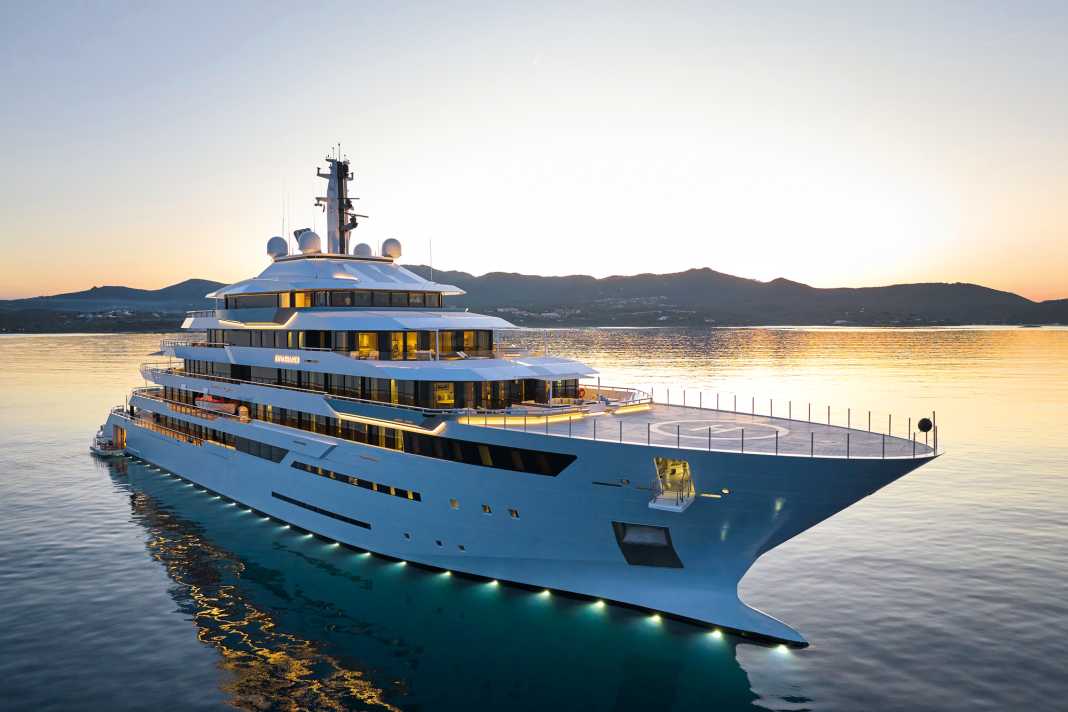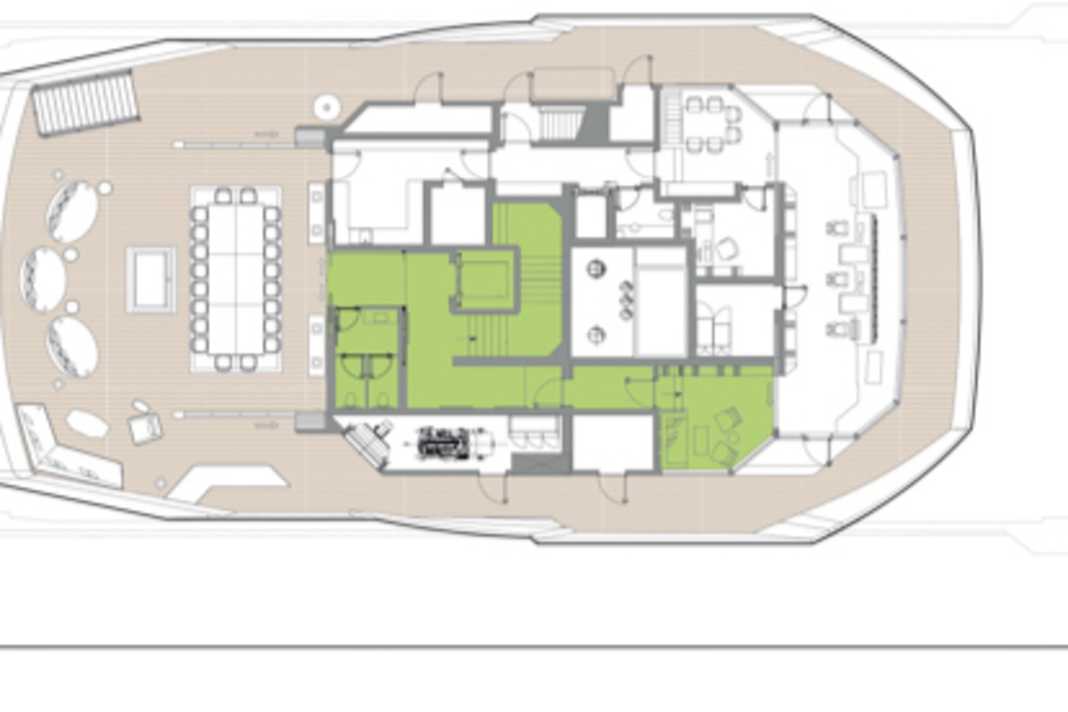"Renaissance": Lush representative of the Giga class comes with the largest yacht gym






Need clearer proof of true greatness? When "Renaissance" enters or leaves Genoa's marina at the airport, all air traffic at the Aeroporto Cristoforo Colombo comes to a standstill. Everything comes to a standstill and lets the Queen move. This precautionary measure is not prescribed by Flight Control because of her length of almost 112 metres, the height is the decisive factor. The six-decker measures 42 metres from water pass to equipment carrier. "We're practically on the runway," says Captain Gordon Campbell with a grin on the helipad. And indeed, the runway is only 100 metres away, turbines are roaring, the smell of burning paraffin is in the air.
"Renaissance" with a name in the Giga class
In combination with the width of 18 metres, the result is an impressive cubature. At 7200 gross tons, "Renaissance" is one of the more opulent representatives of the Giga class and, contrary to its name, could be categorised as Baroque. For comparison: "Rising Sun", the 138-metre Lürssen designed by Jon Bannenberg, has an interior volume of 7840 gross tonnes. "Renaissance" designer Dickie Bannenberg, who designed the exterior and interior with Bannenberg & Rowell, jokingly says: "We can't calculate how many London buses would fit in 'Renaissance', at least that would be our rule of thumb. But there must be many, many garages full." For the British office, it was the biggest project in the studio's history, and they tried to rob it of some of its giganticness. Simon Rowell's means of choice were bevelled, sometimes protruding edges, which create a kind of stealth effect and prevent the decks from looking like a long, plain strip facade.
Why did the 112 metres become so voluminous? "Seven years ago, we started talking to a couple who had been chartering yachts for many years. They had an extraordinarily ambitious yacht project in mind - with space for 36 guests," says Dickie Bannenberg. He inherited the penchant for large-scale projects from his father Jon Bannenberg. In fact, "Renaissance" spans two studio eras: The owners still own the drawing of a 42-metre yacht that Jon Bannenberg drew for them almost 40 years ago, but which was never realised.
Before "Renaissance", I never built my own yacht, but I did spend countless holidays on board top-class yachts on the charter market. The consequences were a few irrevocable requirements that were based on personal preferences and trends of the past three decades. The ideal design of a charter yacht, if you like. With a deck just for the owners, a huge gym and spa area, sushi bar, pizza oven, cinema with 19 seats and a spacious beach club. In addition, there are high ceilings in all cabins, a ten by five metre pool and culinary stations on all levels. On "Renaissance", everything seems bigger: be it corridors, walking decks or the handrails of the railing, which are as thick as a small iPhone.
Harmony on board
The best way to approach the giant is from the very top. At the back of the bridge is the largest outdoor dining area with seating for 20, framed by two barbecue stations and a DJ booth. A TV can be folded out of the ceiling on request. The steering position has commercial dimensions, yet the guest lounge has been moved slightly aft to the level of the starboard dock and separated by a sliding door. "In my experience, many guests leave the bridge again quite quickly after a brief chat. The separate area is a bit more informal and better suited to relaxing," says the captain, who has already signed on a 300-metre-plus cruiser and a 130-metre yacht. Campbell, who shares the "Renaissance" command with a colleague in rotation, recently supervised a shipyard stay of several months at Amico in Genoa. He emphasises how important it is with such a large format to fine-tune the systems so that the air conditioning and underfloor heating run in perfect harmony.
On the owner's deck below, the pile of silk carpets also caresses the feet. It is here at the latest that you become aware of the gigantic dimensions; the Beletage extends from the dining and lounge area aft to the Jacuzzi forward over a length of 55 metres. Everything in between was built by the South Tyrolean carpenters from Höller, while the Spanish company Cándido Hermida was responsible for the majority of the interior spaces. At the top of the colour scale were taupe, beige and cream - neutral tones that should appeal to the majority of guests. There are few high-gloss surfaces and, unusually for Bannenberg & Rowell, no stainless steel accents. Instead, matt leather and bronze elements in wooden furniture and doors.
In the sleeping area with bow view, seating to the sides of the bed reveals the lavish use of space. Heavy curtains darken the room. Like the light or temperature, they are adjusted via iPads. They are also used to call the crew or via waterproof Bluetooth wristbands that every guest receives. However, the owner did not want to do without corded telephones. Instead of televisions in the sleeping area, the decision was made in favour of a TV lounge directly behind it, from which the two bathrooms with identical layouts, each with a bathtub, lead off.
The owner's floor is completed by walk-in wardrobes and an office for her. He manages the ship three decks below in the immediate vicinity of the main saloon and next to a business centre with four workstations. There are also four VIP suites on the main deck, each with balconies, of which the two forward ones can be partitioned off to form two extra cabins thanks to foldaway beds. There are also ten double cabins on the lower deck and two smaller cabins with single beds, which are suitable for nannies or personal trainers, for example. All guest accommodation is numbered on signs and also assigned to a city or island, which is shown in a photograph above the bed. Identical works of art in different colours on the decks provide additional orientation. A central Otis guest lift connects the individual levels.
Passenger Yacht Codes exerts influence
"Renaissance" was built in accordance with the Passenger Yacht Code (PYC). This is a catalogue of requirements that must be met in order to be allowed to take 36 passengers on board for non-commercial use instead of the otherwise permitted twelve. PYC entails considerable additional work, which affects both technology and design. Measures included watertight bulkheads, strict requirements for stability and crew quarters as well as comprehensive fire protection. The passage "limited use of combustible materials" should be emphasised here. In addition, there were escape routes and wide corridors with handrails as well as IMO-compliant lifeboats stored on the running decks.
For Freire, it was a PYC premiere and only the second superyacht after the "Naia" (74 metres), which was launched in 2011. The Galicians are experts in special shipbuilding and had the steel-aluminium hull welded at Kleven in Norway. Plans were supplied by the Norwegian design office Marin Teknikk, which also calculated the "Multiverse" and "Andromeda", which were also half-built by Kleven. Like the "Renaissance", the two explorers were delivered with hulls that were not completely filled. They did not receive their yacht finish until a year later. This was done to give the weld seams time to "set".
More than 600 people involved in "Renaissance"
More than 600 people worked on "Renaissance" in Vigo in northern Spain, with Freire providing more than just a shipbuilding hall and not limiting himself to managing the suppliers. "Freire took many things into his own hands. That's why some things like the bridge have become more commercial," says Captain Gordon Campbell. The drive unit from Kongsberg has also only powered a few yachts to date. The Norwegians supplied two Azipull pods with towing propellers and a maximum output of 2500 kilowatts each. The required power is generated by five CAT gensets, each with a power output of 1840 kilowatts, which - when 641,000 litres of diesel are sloshing around in the tank deck, which is up to 5.10 metres deep - allow non-stop journeys of up to 8,600 nautical miles at twelve knots.
Under full load, the colossus reaches 16 knots. "We have a lot of extra power. Thanks to pods, we can move sideways in 60 knots of wind." During his time on the cruise, Campbell even operated three propulsion pods and emphasises: "You can also use the windage to your advantage and let the wind push you out of the marina, for example." Ten crew members would have to be on deck to dock, four at the front, two in the centre and four at the back.
Five generators on "Renaissance" ensure the autonomy of the systems, which include a pair of fin stabilisers. However, the auxiliary generators can also drive the rudder propellers. Campbell cruises with two large and one small generator and manages 11.5 knots with two large ones. "On the Amalfi Coast, I only run one small generator because the distances are so short." At a cruising speed of twelve knots, fuel consumption is 1125 litres per hour - a figure that Burgess also quotes for the flagship of the charter fleet. This is because fuel costs are not included in the weekly utilisation rate.
"The pods massively reduce consumption," says Gordon Campbell. Instead of the usual 20 per cent APA (Advance Provisioning Allowance), Burgess charges 30 per cent of the three million euro rate for "Renaissance". This also includes the provisions. "However, the APA can also go up, depending on the charterer's requirements," emphasises Burgess' charter manager Caroline Taylor in the main saloon. The APA alone exceeds the total cost of a one-week charter of a 60-metre format.
Target group and destinations of the "Renaissance"
At the time of the visit, the 45-strong crew had not yet welcomed any charter guests on board, but had two paid voyages in prospect: one for a fortnight at a time and one for 24 people. Multi-generational holidays, weddings or incentives are conceivable. "It's new for us to have a yacht of this quality and with this many cabins in our portfolio," says charter professional Taylor. Most guests are drawn to the Amalfi Coast, Sardinia or St Barth. The Caribbean is scheduled for winter 2024/2025, and a year later a somewhat more "adventurous destination" could be on the cards, "provided there is sufficient demand". The Freire-Giga is equipped for high latitudes; the steel hull has been awarded ice class 1D certification.
The spa, which occupies the level above the main deck, was very popular on the first cruises with owners and guests. The chief stewardess reports from the hairdressing salon with two places and a washbasin: "Next door there were massages, or the guests got a pedicure. They would lie down or come here for a manicure." On the port side, there is a sauna, steam bath and two plunge pools, one with warm water and one with cool water at six degrees. Many crew members have dual qualifications, including spa therapists, hairdressers and personal trainers.
The largest yacht gym and a 180-metre outdoor running track
"We have a yoga instructor on board and, no matter what time of day they want to do yoga, we would prepare everything," says Chief Stew. The fitness-loving owner wanted the largest gym ever seen on a yacht. It is roughly the same size as the large saloon and, as expected, is over-equipped. The "Renaissance" R is emblazoned on various free weights, and the ceilings are so high that the treadmills don't need any recesses. A jacuzzi awaits aft, which is unusually deep at 1.40 metres. Fittingly, the spa deck allows 180 metre long jogging excursions in the square. There are also two eyelets on the ceiling for punching bags.
One deck below, the gallery forms a kind of catwalk that leads to another lounge area and outdoor round table with a diameter of five metres. In the salon below, conceived as an atrium, Bannenberg & Rowell make a direct reference to the eponymous art epoch: Backlit stained glass windows shine in the corners, each with a seasonal interpretation by British artist Grace Ayson. The room dividers in the central corridor contain woven metal by Sophie Mallebranche. Up to 30 people can dine at the table behind, while those opposite indulge in ennui or casual conversation.
The "All that Jazz" bar is located separately in front of it, with an exquisite cognac collection in front of translucent onyx and corresponding instruments. "Intimate, atmospheric and above all sociable, it offers generous seating and trumpets. Of course, these had to be tested in the studio. Various broken glass panes have been replaced and the cats from the neighbourhood have returned to their owners," jokes Dickie Bannberg. The jazz bar offers a splendid view of the airfield of the Genoese aerodrome. Landing there and boarding without a diversion via the "Renaissance" terminal remains a fantasy. A lot is possible in yachting, as the 112 metres prove, but not everything.
Technical data






- Length over everything: 112 m
- Waterline length: 98,40 m
- Width: 18 m
- Depth: 5,10 m
- Gross tonnage: 7200 Gross Tons
- Material: Steel, aluminium
- Motors: Caterpillar, 5 x 1415 kW
- Speed (max.): 16 kn
- Speed (travelling): 12 kn
- Generators: 5 x Caterpillar
- Range @ 12 kn: 8600 sm
- Fuel: 641 000 l
- Water: 167 000 l
- Guests: 36
- Crew: 45
- Construction: Marin Teknikk
- Exterior design: Bannenberg & Rowell
- Interior design: Bannenberg & Rowell
- Class: Lloyd's Register
- Shipyard: Freire Shipyard, 2023
- Charter: Burgess, from 3 million euros p.w.

